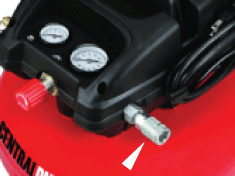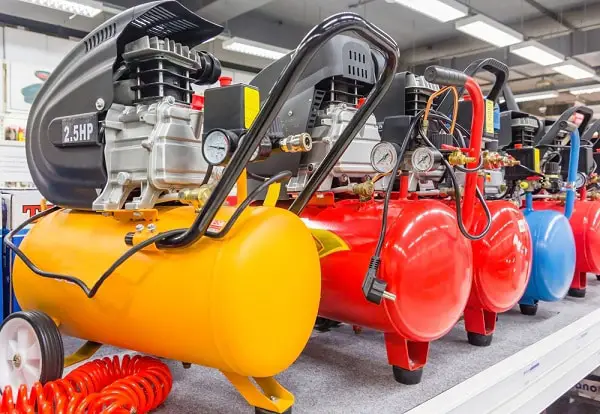How come there is no air getting to my air tool?
I have checked the tank pressure gauge, and it shows that I have lots of air pressure inside the air tank. Almost 150 PSI is what is showing on the tank gauge.
I check my air regulator, and it shows a setting of 90 PSI. That means that, when I fire up my air tool, the air pressure flowing down the air line to the air tool is at 90 PSI.

Which air gauge is which?
Usually, the air gauge that displays the setting on the pressure regulator, is the gauge closest to the discharge coupler.
The discharge coupler is the coupling into which you plug the air line to get air to your air tool.
Air tool operating pressure
You know – since you read the manual – that the air tool needs to have a supply pressure of 80 PSI. You have got to be sure that it’s getting that air pressure to be sure it’s working properly.
Also, you have dialed up the regulator setting to 90 PSI as you do know that air pressure drops as the air travels through the air line, so to make sure the air tool is getting the 80 PSI it needs, you have dialed up the pressure a bit at the regulator.
But, there is no air getting to my air tool. What’s wrong?
How do I know there is no air pressure getting to my air tool?
Well, either I pull the trigger and nothing happens, or I pull the trigger, the air tool starts weakly, and then dribbles to a stop.
Either way, it seems that my air tool is starved for air.
The first thing to look at is…
The first thing is to look at is the air hose. Check it from end to end.
Is it plugged into the compressor coupler properly?
Did you accidentally park your tire car on a section of the air hose? 🙂
Is it plugged into the air tool correctly?
Assuming that there is nothing on the hose, or that there is nothing in the hose to block air flow, and that the hose connector is plugged into the discharge coupler correctly, and the air line is plugged into the air tool correctly, then, lets look at the flow of air through the compressor.
Let’s look at the flow of air next!
Air is pumped into your compressor air tank when the pump runs. When the tank is full of air, the compressor has stopped. If this is the case for your air compressor, then your air tank is full of compressed air, ready to use.
Air gets out the tank via an air line that typically runs first to the tank air gauge, and then to a regulator, to the regulator air gauge if that gauge is not mounted on the regulator itself, and then to the discharge coupler where it waits until you plug a connector into the discharge coupler, and compressed air starts to flow down the air line.

We have compressed air in the tank. The regulator is showing 90 PSI. Assuming air is flowing through the regulator, then we have 90 PSI at the discharge coupler. Why no air in the hose?
At this point I would suspect that the regulator is the problem. A quick check would be to use a small, wooden, stick inserted into the end of the discharge coupler.
Be careful. Air and debris flows very quickly and if you are looking into the discharge coupler when you depress the ball check at the end inside the coupler, you could get blasted by air. Wear work gloves.
Position the stick, small enough to fit, so it is touching the ball check, move your face away from the opening, and depress the ball check.
If the regulator is working properly, you should get quite a loud blast of compressed air, and that blast of air should continue as long as there is air in the tank.
If you get low flow of air, or no flow of air, you can bet that the air regulator has failed, and it is blocking the flow of air from the tank to the discharge coupler.
Unless you know where to get parts and want to take the time to disassemble and reassembled the regulator, it’s likely time for a new compressed air regulator!
I have lots of air out of the discharge coupler!
What if you get lots of air out of the discharge coupler, and the flow continues strongly until the tank pressure drops and the compressor starts? That would suggest that the problem is not the regulator.
More things to check include:
- Is it a new air line connector your are plugging into the compressor coupler?
- That being the case, are you certain that the new connector is compatible with the old coupler? If they are not a matched set, inserting the wrong connector may not open the ball check sufficiently to allow full air flow.
- Double check the air flow through the hose.
- Check the air flow through the hose by using the same wooden stick on the discharge coupler at the end of the air hose. If you are not getting full flow out that coupler, then you have a hose blockage of some sort. Be careful in so doing!
- Is there debris in the connector in the air tool?
- Air tools often sit around on work benches, and it is possible that debris has found its way into the connector on the air too. To be sure, try a different air tool with a different connector to see if a different air tool has sufficient flow. If so, then it is either debris in the air tool connector or the air tool itself is fouled or failing.
Questions? Comments? Please use the form below.


I am building air in the tank but i have no pressure on the air REGULATOR gauge. Do i need to replace the regulator?
Patrick, I am a bit confused by your question. I don’t know what make or model a PSI 150 compressor is to start with. And the gadget you refer to is, I believe, the tire chuck, which is an interface between the coil air hose and the tire valve. Placing the tire chuck on the tire valve properly will allow air to flow from a higher pressure source into the lower pressure area – in this case a tire that needs air. If air is flowing out of the tires when you place the tire chuck on the tire valve… Read more »
I bought the PSI 150 for little things like air in my bicycle tires, air in my snow blower tires and riding mower. This spring I attached the gadget that goes on the end of the yellow hose to my bike tires. It ended up taking air out of the tires. Never did this before. Are there bicycle nosel attachments for this model? Patrick